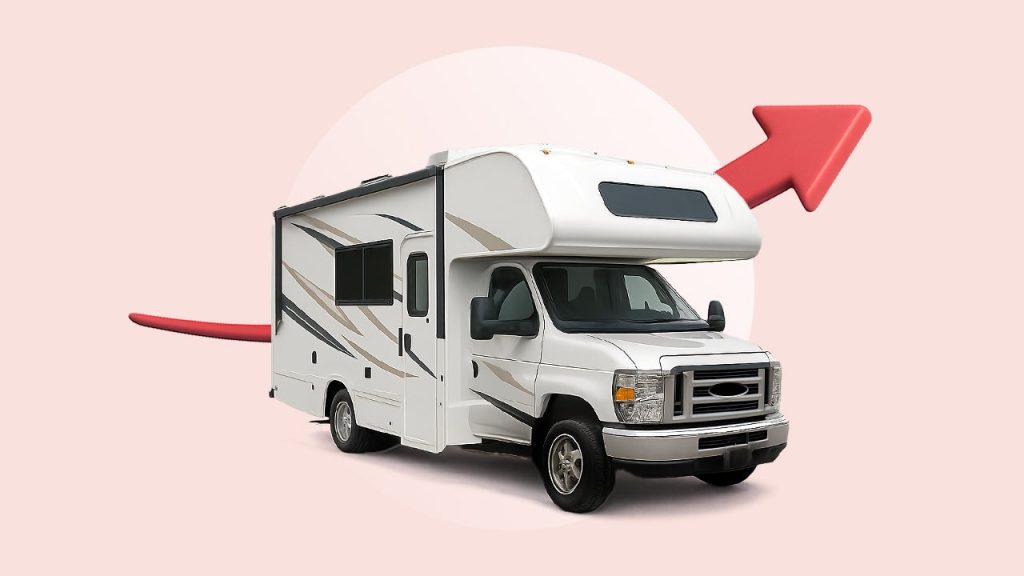Image by GettyImages; Illustration by Bankrate
Key takeaways
- Typical unsecured RV loan terms range from five to seven years, but this timeline may be shorter or longer, depending on the lender.
- Secured loan terms may exceed 12 years.
- Shorter repayment terms save you on interest, but the trade-off is a higher monthly payment.
- Longer repayment terms (up to 20 years) give you a lower payment for more expensive RVs, but cost you more in total interest.
If you’re looking for an unsecured personal loan to finance an RV, you’ll find that most lenders offer terms between five to seven years. Terms on secured loans may range up to 20 years. The term you choose can give you a low payment for a fancy RV ride or help you finance an older vehicle that banks or credit unions won’t lend on.
Term length is the second-biggest factor in determining the cost of an RV loan, after interest. Knowing what your options are can help you pick the right repayment term on the best RV loan for your home on wheels.
Typical RV loan terms
The standard loan term for RV financing varies depending on whether you choose a secured or unsecured loan. You’ll usually find unsecured loan terms capped at seven years, although a few lenders will extend the term out to 12 years on an RV loan.
You may find dealer financing or secured RV financing options offering terms as long as 20 years. It all depends on the overall cost of the vehicle, your finances and the lender you work with. Longer financing timelines (15 to 20 years) tend to be limited to loans secured by larger RV models. That’s because some RVs may cost as much as tiny houses.
Learn more: Should you buy or rent an RV?
Factors that affect your RV loan terms
Lenders primarily look at your credit and income for approving unsecured RV loan financing. The higher your scores and income, the more likely you are to qualify for low rates or longer terms.
The model, make, age and condition of your RV come into play if you’re looking for a secured loan. You may not be able to get a secured RV loan if you have bad credit or are buying an older used RV. Common factors RV lenders consider include:
- Loan amount: Lenders typically limit longer RV financing terms to larger loan amounts. Secured lenders may be willing to offer longer terms if you’re buying a brand-new RV with a lot of bells and whistles included.
- Your credit score: The higher your credit score, the more likely you are to qualify for longer term lengths. A good FICO credit score is between 670 and 730. You may be limited to a shorter term if your credit score is low.
- RV condition and age: This factor only applies to secured or dealership RV loans. Like car lenders, RV lenders tend to offer the most financing incentives for expensive new vehicles. Also like cars, RVs depreciate with time. Your lender often restricts term lengths and amounts based on the model’s age to reduce the risk of being unable to resell the RV for a profit if it has to repossess it. Whether your RV is new or used and its features that may affect the price are also considered.
- Type of lender: Dealerships often offer longer repayment terms than personal loan lenders, like banks, credit unions and online lenders. These lenders offer terms ranging from two to seven years. Meanwhile, dealerships may offer repayment terms of up to 20 years, making them a better option if you plan on buying new.
- Your desired monthly payment: A longer repayment term often results in a lower monthly payment. However, this also translates to more interest paid over the life of the loan than if you chose a shorter repayment timeline. Use a loan calculator to check your monthly loan payment to see if it is an affordable option for you.
- Down payment percentage: If you’re buying an RV from a dealer or financing it with a bank, you may have more flexibility with your loan term if you make a down payment. Ask the lender to run several options if you have the extra cash to make a 15 or 20 percent down payment.
How to choose the right length of your RV loan
A shorter term results in spending less on interest overall but more each month, while a longer term long may have a less expensive monthly payment but cost more in interest.
Here are some general guidelines to follow for picking the right RV loan term:
- Pick a longer term if you need a low payment. If you’re buying a pricey RV and need to keep the payment low to fit in with other financial goals. For example, a longer term will leave you with more room to stay on track with retirement, college fund building or overall savings goals.
- Choose a short term for a quick pay-off. If you want your RV ride to be paid off as quickly as possible, take a look at three- or five-year terms and see if you can manage the payment. You’ll also save a bundle in total interest by paying the balance off faster.
RV loan number crunching
The longer your repayment term, the more interest you will pay over the life of the loan — even with a lower rate. For example, if you have excellent credit you might qualify for a 7.99 percent interest rate on a $50,000 RV loan that will cost over $16,000 more for a 10-year term versus a three-year term.
|
Monthly Payment |
Total Interest |
|
|
3 years |
$1,567.00 |
$6,397.15 |
|
5 years |
$1,014.00 |
$10,814.83 |
|
7 years |
$779.00 |
$15,441.18 |
|
10 years |
$606.00 |
$22,764.86 |
The bottom line:
- A $50,000 loan with a 17.99 percent interest rate will cost you around $15,000 in interest over the course of three years.
- If you bump your term up to seven years, you’ll wind up paying over $38,000.
Bankrate tip
Choosing a longer repayment term could mean more comfortable payments, but it can also put you at risk of having an underwater loan. That means having negative equity because you owe more than the asset is worth. If that happens, you may have a hard time refinancing the loan. You will also struggle to sell the RV for enough money to cover your remaining debt, should you need to.
Bottom line
Picking the right RV loan term often comes down to affordability. RVs can cost between $10,000 and $1 million, and a longer term gives you the lowest possible payment. However, if you don’t want to be making payments on your RV for the next 20 years, a short term will clear the balance out much faster.
An unsecured personal loan is best if you’re not buying the latest make and model, and don’t want to deal with the hassle of having your RV vetted by a lender. However, dealership financing may come with more perks and a much longer repayment period if you’re a regular RV traveler.
Why we ask for feedback
Your feedback helps us improve our content and services. It takes less than a minute to
complete.
Your responses are anonymous and will only be used for improving our website.
Help us improve our content
Read the full article here












